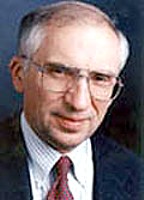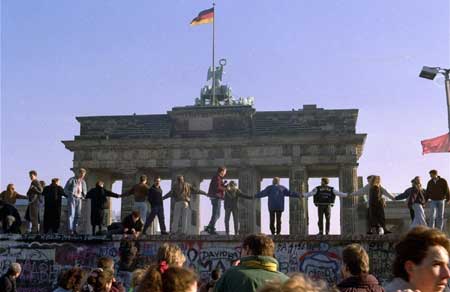Essay (back
to top)
Summary
In The Rush to German Unity, Konrad H. Jarausch examines the unification of East and the West Germany in the waning days of the Cold War that divided the world into two opposing ideologies. Jarausch begins with the growing discontent of the people of German Democratic Republic, and the resulting mass exodus of the GDR Germans seeking the freedom and prosperity of the West. This mass exodus to the Federal Republic of Germany demonstrated the growing discontent of the declining East German economy. In describing the East German people’s role in the downfall of the SED party rule of the German Democratic Republic, Jarausch describes the looming political movement of perestroika supported by the Soviet leader Mikhail Gorbachev. This movement for restructuring of the old Communist government gave the East Germans a green light to seek reform in the government of the GDR as well. This call for reform forced the ruling SED party to act, finally bringing the spirit of perestroika to the obstinate Stalinist regime under Honecker by replacing Honecker with Krenz. In an effort to satisfy and calm the East German dissent, the new SED rule under Krenz opened up the Berlin Wall, the symbol of Cold War. The new freedom of travel only whetted the appetite for more freedom and foremost, the western goods and the consumer market that provides those goods. The deteriorating economy of East Germany led to increased involvement of the non-SED parties in the government and the rising support for a Third Way between the capitalism and the communism. Despite the attempts by some intellectuals to retain the East German identity, the economy still posed a problem. The drastic difference of wealth between the East and the West Germans ultimately led to abandoning what Jarausch calls the socialist dream and the Third Way. Starting with the unification of the currencies, the two Germanys began to pave the path towards unification.
Essay
The defeat of Nazi Germany at the end of World War II raised the proverbial “German Question” once more. The fear of united Germany exercising its power in European affairs by the rest of Europe sought to separate Germany. The decision made in the Yalta Conference separated Germany into essentially two distinct nations, along with Austria. West Germany practiced capitalism and democracy under the supervision of Britain, France, and the United States, while the East Germany practiced the command economy and communism under the supervision of Soviet Union. The ensuing Cold War dissipated the hopes for re-unifying the divided Germany. Caught in the ideological battle between capitalism and communism, Germany’s division epitomized the seemingly polarized world of the Cold War. Citing various archives, collections, documents, and memoirs, Konrad H. Jarausch proposes in his book The Rush to German Unity that the unification of Germany came about from economic disparity between East and West Germany that stemmed from inflexible political and governmental structures of the East Germany. Jarausch also proposes that the unification process involved difficulties of integrating two different models.
The fall of Berlin Wall saw massive influx of East Germans visiting West Germany in an effort to confirm the tales of prosperity that East Germany saw on television. The tragic situations of divided families also provided methods to compare the life of West Germany with the East. The great disparity between Deutsche Mark of West Germany and the Mark’s value in East Germany led to many trained professionals to flee East Germany. Subsequent loss of skilled and the most productive laborers struck hard on the East German economy. In a vicious cycle, this higher value of Deutsche Mark attracted the skilled workers of the East Germany to the West. The mass exodus to the West formed around these skilled workers who most contributed to the growth of the East Germany. The loss of these skilled workers disrupted the economy of East Germany. The already obsolete factory machines came to disrepair, and this led to poor qualities in the products: “If there were more than enough shoes, they would be ugly and in the wrong sizes. Since most goods were shoddy, finding the few quality items, largely imported, became an obsession”(Jarausch, 98). The planned economy of East Germany failed to compete with the capitalism of the West, and the East Germans looked towards West for solution to their hunger for quality market goods. Jarausch cites this cycle of economic downfall as the deep rooted source of the discontent in the East Germany and that East German government knew of coming disaster: “According to secret figures, nominal growth dropped from 4.5 percent to 3.1 percent during the late 1980s, only to stall completely at the end”(Jarausch, 97). This figure illustrates the gradual loss of the East German government’s ability to run the country, which reflected in the daily lives of the East Germans in their dissatisfaction with the consumer goods available. On top of the declining growth in the East German economy, the desire for market goods of the West topped with widening exchange rates between Deutsche Mark and the East German mark placed greater strain on the East German economy: “During the 1980s the amount required to earn one Western DM rose from 2.2 to 4.4 Mk, an effective devaluation by half!”(Jarausch, 140). This continuing loss of East German mark’s value in comparison of the Deutsche Mark meant that only East German elites could shop for luxury goods in the coveted market of the West Germany.
The political elites used the economic hardship to maintain power. Using the privileges of shopping in the West as an incentive, the SED party sought to hold onto the skilled workers leaving East Germany for the West with proven tactics of the past:
Scarcity put a premium on personal and political connections. The fortunate few who could offer attractive goods or services bartered in kind. Some of the best houses in town were owned by carpenters, plumbers, and other craftsmen with scarce skills who helped one another on weekends(Jarausch, 98).
Despite these measures of reforms after the fall of the Berlin Wall, the exodus continued. The exodus symbolized the diminishing legitimacy of the SED to lead the East Germany in the time of crisis. The SED, for its part, tried to extend power to the non-Communist parties such as Christian Democratic Union within East Germany. The intellectuals and dissidents who clamored for reform began to participate in the politics of the East Germany: “Frightened by potential anarchy, moderates looked for a way to bring the opposition into dialogue with the Modrow cabinet”(Jarausch, 75). The cooperation among the parties across the spectrum within East Germany attempted to revitalize the waning socialism by finding a ground between capitalism and communism. This search for a “third way” came from uncertainty of the West due to incessant propaganda, and some of the repelling qualities such as lacking some of the social benefits(Jarausch, 77). The Third Way found supporters outside of East Germany as well as inside. The promise of maintaining an East German identity without accession to the West seemed attractive, and outside supporters saw a chance to experiment with a new political ideology: “The GDR has a unique chance to build a new social system, freed of the Communist version of Socialism and uncorrupted by capitalist principles”(Jarausch, 79). This optimism for reform was short lived, however, as the popular sentiments quickly turned towards total unification with the West.
The people of East Germany grew frustrated as the reforms enacted by the Third Way movement proved unable to improve the deteriorating economy, guarantee liberties, or satisfy the desire for market goods. Jarausch characterized the East Germans’ achievements that also augmented the desires from their government: “[T]he people, acting as one, had determined their own fate with imagination and resolve”(Jarausch, 95). Such struggle raised expectations of the people. When the people’s desire proved too much for the SED which was therefore forced to constrain its own people through Stalinist means, the people erupted with urgency. Focused on the Stasi, the secret police of East Germany, the East Germans voiced their desire to abolish the oppressive body of the government that carried out the SED policies. The rejection of a Third Way and the continued desire of the people for democratization led to the complete demise of GDR, integrating itself into FRG. This unification process also yielded its own problems.
As mentioned before, the currency inequity between the East and the West caused the massive exodus in search of wealth by the skilled workers of the East Germany. When unification called for converting the East German mark to Deutsche Mark, opposition grew. They warned of financial and economic repercussions. Such talk hindered the decision on establishing the exchange rate. After heated debate on the subject, the two German governments came to a compromise. Also, the forewarned necessity to raise taxes to make up the difference in production capabilities of the two Germanys came as Eastern recovery program. This program raised the income tax by 7.5 percent(Jarausch, 204). This increase in tax contributed to the tension building between the East and the West Germany. Such difficulties created friction between the fellow countrymen, but they also demonstrate the degree of change caused by the decades of life under two opposing ideologies with radically different economic systems.
In his analysis of the German unification, Konrad H. Jarausch demonstrated the union of East and West Germany came with hard struggle by the people of East Germany in their demand for better access to better market goods, their demand for removing the Communism from power, and negotiations and communication between the two opposing ideologies. Jarausch also demonstrates in his book that the main drive for the unification came from economic concerns of the East Germans, as well as the common blood shared by both Germans in a brotherhood.
|
 Konrad Jarausch
Konrad Jarausch